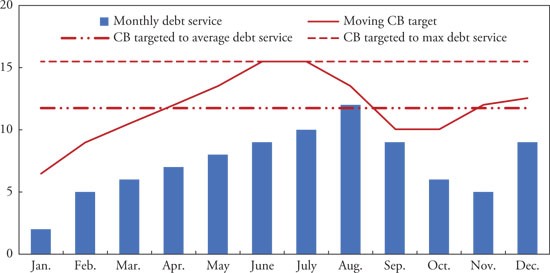Financial security is a cornerstone of a fulfilling life. It shields us from the unexpected twists and turns that life throws our way, giving us the confidence to pursue our dreams. One tool in our financial arsenal that often goes underappreciated is the cash buffer.
While primarily viewed as an emergency fund, it can be a game-changer in our journey towards financial independence. In this blog post, we’ll delve into the world of cash buffers, exploring their potential beyond emergencies.
We’ll also dissect two intriguing strategies: enlarging the cash buffer and the concept of refilling it. By the end, you’ll have a better grasp of how these strategies can shape your financial future.
The Power of Cash Buffers
Cash buffers serve as a financial lifeline during turbulent times. Whether it’s unexpected job loss or unforeseen expenses, having a stash of readily accessible cash can help you navigate through choppy waters without sinking into debt. More importantly, it provides peace of mind, alleviating the anxiety that often accompanies financial instability.
However, cash buffers aren’t a one-trick pony. They can be harnessed for a broader range of financial goals, particularly when combined with other strategic approaches. For instance, when you’ve achieved financial independence, a cash reserve can act as a complement to your emergency fund. It can serve as a shield, protecting your investments during market downturns without requiring you to tap into your nest egg or sell investments at a loss.
Enhancing Financial Independence

Here’s where the magic happens.
By leveraging cash buffers strategically, we can accelerate our journey towards financial independence. This not only allows us to achieve our financial goals sooner but also minimizes the risk associated with market downturns—the nemesis of the safe withdrawal rate method.
Exploring the Cash Buffer Tweaks
Today, we’re going to dive deep into some intriguing tweaks that can significantly impact your financial journey. We’ll explore two main strategies: enlarging the cash buffer and the concept of refilling it. These strategies, when combined with other financial tactics, have the potential to reshape your path to financial freedom.
Enlarging the Cash Buffer
One of the first tweaks that financial enthusiasts have experimented with is making a more substantial cash buffer. Instead of relying on a buffer that covers two years of essential expenses, some individuals opt for three, four, or even five years’ worth of expenses. While this approach offers increased financial security, it’s essential to analyze whether it reaches a point of diminishing returns.
Let’s consider an example. If you build a three-year cash buffer, the minimum safe withdrawal rate for a 30-year retirement plan rises to approximately 3.82%. However, expanding the buffer to five years only increases this rate to 4.1%. While this might seem like a notable improvement, it comes at a cost in terms of time and effort.
To build a three-year buffer, you’d need to accumulate $48,000. With a five-year buffer, this amount increases to $80,000. Assuming you aim for a $40,000 annual retirement income, your required nest egg with a three-year buffer is approximately $1,047,000. With a five-year buffer, this requirement drops to around $997,500, saving you roughly $49,500.
While increasing the cash buffer is undoubtedly beneficial, it’s important to weigh the trade-offs. For many, the extra effort and time needed may not be justified when compared to other approaches.
Refilling the Cash Buffer
The second intriguing tweak involves refilling your cash buffer once your investments have recovered from a previous market downturn. The idea here is to ensure that you always have cash available to cover expenses when the market is down, avoiding the need to sell assets at a low valuation. However, the impact of this strategy might not be as significant as it first appears.
Upon rerunning simulations with a two-year refillable cash buffer, we find that the minimum safe withdrawal rates remain nearly identical, hovering around 3.67%, 3.53%, and 3.41%. Surprisingly, the average withdrawal rates across all scenarios slightly favor not refilling the buffer, albeit by a slim margin of 0.03%.
The rationale behind this outcome is quite straightforward. Over the long term, investments tend to outpace the growth of cash. Even when considering a nominal 2% interest rate on the cash held in the buffer, stocks historically generate returns averaging around 10% annually before inflation. Refilling the buffer essentially involves moving funds from an asset with a 10% average return to one with only a 2% return.
While there are situations where refilling the cash buffer can yield advantages, such as when paying off high-interest debt or reducing expenses, the difference in capital preservation between refilling and not refilling during major market downturns remains minimal.
The Role of Asset Allocation
The impact of these tweaks can vary depending on your chosen asset allocation. For example, let’s consider a classic 60/40 portfolio with 60% in stocks and 40% in bonds. Applying the same parameters as the initial cash buffer simulation, the minimum safe withdrawal rates experience slight reductions.
The minimum safe withdrawal rates drop from 4.1% to 4.05%, and the average safe withdrawal rates for the refillable buffer trail behind the non-refillable scenario by nearly 0.05%.
Combining Strategies
Now, let’s explore the synergy between these cash buffer tweaks and other strategies. Imagine utilizing a standard two-year cash buffer, reducing your expenses to your inflation-adjusted essential spending whenever your investments decline by 20% or more from all-time highs, employing financial guardrails to ensure your withdrawals stay within 20% above or below the initial safe withdrawal rate, and adjusting projected withdrawals by 10% when they fall outside these guardrails.
Additionally, you establish a spending floor during non-downturn years at $30,000. Under these circumstances, the 30-year minimum safe withdrawal rate climbs to approximately 8.25%.
However, if you opt to refill the cash buffer, the minimum 30-year safe withdrawal rate drops to roughly 8.9%. The average withdrawal rates also decrease by a comparable margin. While these numbers may seem promising, it’s crucial to remember that these tweaks come with trade-offs, including lowering your safe withdrawal rate and extending the time needed to achieve financial independence.
Are These Tweaks Worth It?
In the grand scheme of your financial journey, are these cash buffer tweaks worth pursuing? The answer isn’t a one-size-fits-all. It largely depends on your individual financial goals, risk tolerance, and preferences.
For many people, the non-numerical benefits of refilling a cash buffer can be appealing. The peace of mind knowing you won’t need to sell investments during a market downturn is undoubtedly comforting, especially for those with more volatile portfolios, such as an all-stock allocation. However, from a purely numerical perspective, these tweaks may not justify the trade-offs of lowering your safe withdrawal rate and prolonging the path to financial independence.
Ultimately, the decision should align with your unique financial circumstances and priorities. Before implementing any strategy, it’s advisable to consult with a financial advisor to ensure it aligns with your long-term objectives.
Frequently Asked Questions
Here are five frequently asked questions about cash buffers and the strategies we’ve discussed:
table { border-collapse: collapse; width: 80%; margin: 20px auto; border-radius: 10px; } th, td { padding: 12px; text-align: left; border-bottom: 1px solid #ddd; } th { background-color: #4CAF50; color: white; } tr:nth-child(even) { background-color: #f2f2f2; }| Question | Answer |
|---|---|
| 1. What is a cash buffer? | A cash buffer is a financial reserve that individuals or businesses maintain to cover unexpected expenses or emergencies. |
| 2. Why is having a cash buffer important? | A cash buffer provides financial security, helps avoid debt in emergencies, and allows for investment opportunities. |
| 3. How much should I keep in my cash buffer? | It’s recommended to have at least three to six months’ worth of living expenses in your cash buffer. |
| 4. Where should I keep my cash buffer? | A cash buffer is best kept in a liquid and easily accessible account, like a savings account or money market account. |
| 5. How can I start building a cash buffer? | You can start by setting aside a portion of your income each month and gradually increasing your savings until you reach your target buffer. |











